TAD Revolution One / Part 2 - crossover
Designing a loudspeaker is a very complex discipline if a certain level of performance should be achieved. Well, you can do it quickly and still have good results. However, should the target be to compete with the best, it takes a great deal of expertise, money and time to make an outstanding loudspeaker. In the TAD Revolution One project, we were spared such an elaborate work: Fortunately, TAD engineers had designed the cabinets, had chosen the drivers, and had put the whole assembly together. They had designed the crossover too, and a good one. Still, after taking care of the cabinets (please read the first part of this saga), the next step was to look at whether it was possible to improve this otherwise competent design.
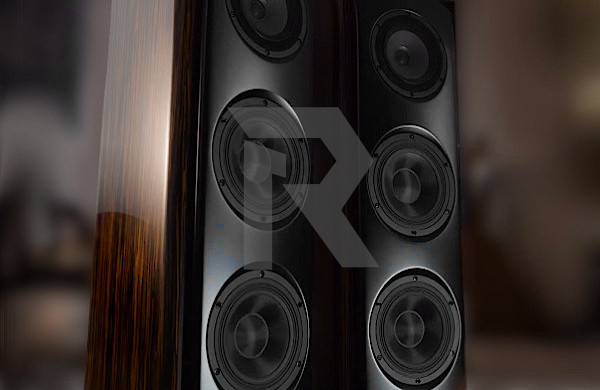
TAD Revolution One / Part 1 – Cabinets
TAD Revolution One / Part 2 – Crossover
TAD Revolution One / Part 3 – Crossover parts
TAD Revolution One / Part 4 – Casework and fine-tuning
TAD Revolution One / Part 5 – Finale
I always liked the sound of my TAD. In my view, the act of upgrading its crossover with better quality parts could be as simple as swapping e.g. the air core inductor for a wax coil and replace the low-grade resistor for a (supposedly) higher-grade resistor. Unfortunately, it does not work like that. Wax coils wound with a lower-AWG wire provide less resistance and it needs to be compensated elsewhere in the crossover. Different resistors provide different sound signature, and it needs to be compensated elsewhere in the crossover. Bigger parts mean bigger space is taken, and it means that some parts cannot be used if you don’t want to place a refrigerator-sized external crossovers next to your speakers. And so on. And most importantly, there are always subjective preferences, like requirements for the target response (or voicing, if you want) of a loudspeaker in a particular room. Therefore, the task of rebuilding the crossover for Audiodrom’s reference room is quite far from the task that TAD engineers were facing, that is to design a crossover that would behave well in multiple rooms, for multiple listeners, and for given budget. Fortunately, I was not alone and was very happy that I could team up with experts.
Silent Laboratories
These guys are (by nowadays terms) a sort of loudspeaker start-up. Like other 1000 loudspeaker building start-ups around the world, right? The passion and dedication that drives most is just one part of the equation, however. What makes Silent Laboratories fundamentally different from other non-professional manufacturers, is that their enthusiasm and open-minded approach is always backed by science. The roots of Silent Laboratories are in the research labs of Prague’s Technical University (Applied Physics Dpt). No wonder that they refuse accepting some audiophile religions and always look for scientific explanations of how speaker parts interact. A good example are complex simulation models of resonances in acoustic systems (for which they build their own software) to foresee changes in behaviour of drivers in speaker baffles. This way they avoid the lengthy trial/error process and maximize the success rate. To be able to immediately apply the simulations to what they do, they have found out that collaborations with 3rd party providers are often slow and problematic, so they have installed in-house 3-D modelling, printing, milling, and welding capabilities. All these are very important as Silent Laboratories specialize in custom-build projects, which is more demanding that designing a one-for-all speaker. A high-end manufacturer usually makes some initial decisions, like who will supply the parts, what types of drivers to choose, which cabinet material will be used etc., and then just sticks to it and improves the formula over years. Unlike that, Silent Laboratories must accommodate the wishes of their customers, e.g. for the choice of drivers and baffles – be it paper, aluminium, beryllium, diamond, cones, domes, ribbons, small size, big size, ported, closed, and many more. The customer knows what he wants in terms of how the finished products should sound (and look like) in his own listening room. Like me. This level of personalization is not available from any major brand. Of course, they have a small catalogue of the ‘factory designs’ to choose from if you don’t have time and patience for the whole development process. Even then, you can ask them to customize any off-the-shelf model to your preferences.
In what they do, the guys from Silent Laboratories are almost fanatical about small details that can – and usually do – make a difference. Sometimes too much fanatical and there were moments in the process, when I had to stop them to settle with the first- or second-best solution, rather than trying to embrace the universe of other alternative options which would obviously take months and years to properly test and evaluate.
So, one morning, Jan Mixa of Silent Laboratories arrived at my listening room with his measuring kit. To start with, we needed to know maximum amount of information about the speaker, its cabinet, and all the drivers. To eliminate the effect of the room, the drivers were measured in two different rooms both near-field and far-field. All documented, Jan left with the original crossovers and his laptop full of plots and data. I have outlined in the Part 1 of this journey, that TAD Evolution One are competently designed loudspeakers. The base measurements in fact confirmed what John Atkinson had found when he had measured the TADs for Stereophile magazine, although we collected much more measured insights about the Evolution One. Here’s a shorter-version summary of Stereophile (JA):
The Evolution One is specified as having a voltage sensitivity of 88dB/2.83V/m. My estimate was almost 1dB higher than this, at 88.9dB(B), which is usefully higher than average. The impedance magnitude […] remains between 4 and 6 ohms for most of the bass and middle ranges, and there is a demanding combination of 5 ohms and –50° electrical phase angle at 27Hz.
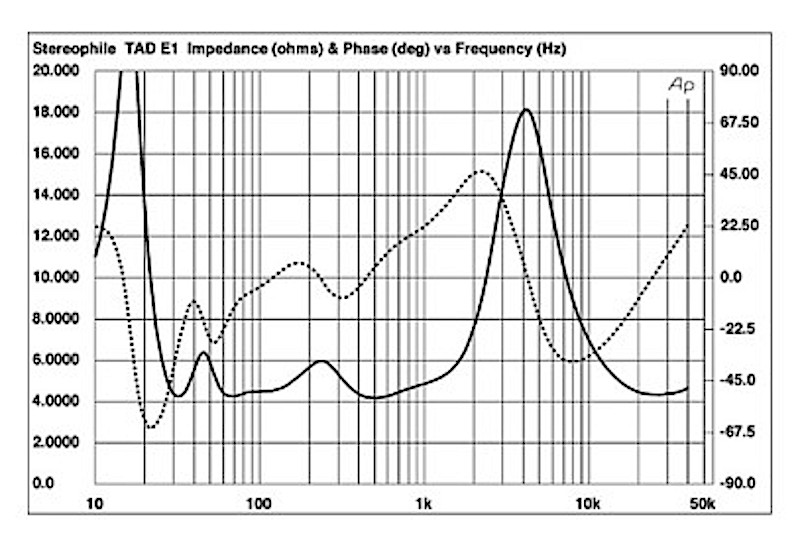
The saddle in the impedance-magnitude trace just above 30Hz suggests that this is the frequency at which the TAD's large rectangular port is tuned. The woofers have identical responses, and the minimum-motion notch in their combined nearfield output […] occurs at a sharply defined 36Hz. The port output (red trace) peaks as expected between 25 and 50Hz, and though there is a slight peak at 150Hz in its upper frequency roll-off, this is well suppressed. The woofers roll out with a high-order slope, crossing over to the midrange driver […] at pretty much the specified 250Hz. The midrange driver rolls in with what appears to be a fourth-order, 24dB/octave slope. Higher in frequency, the Evolution One's response on its tweeter axis is remarkably flat through the midrange to the mid-treble, with some peaks and dips above those regions that result from the symmetrical acoustic environment seen by the coaxially mounted tweeter.
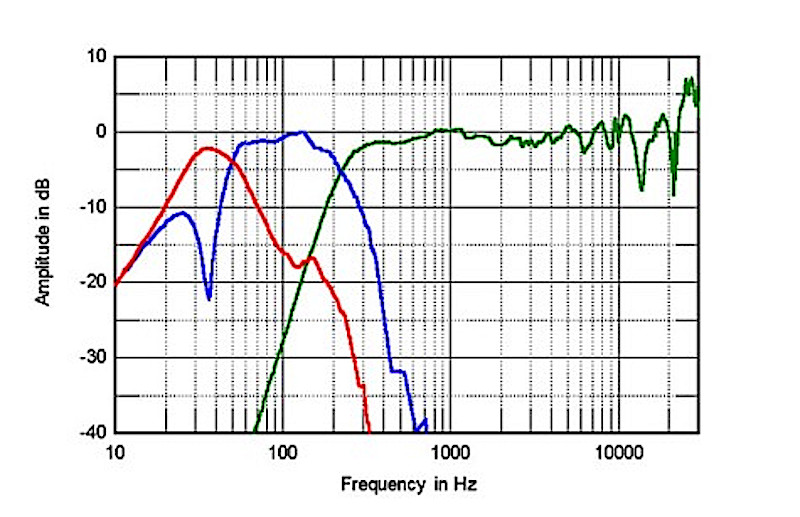
The plot of the Evolution One's lateral dispersion, referenced to the response on the tweeter axis, indicates that the on-axis peaks and dips in the high treble tend to even out to the speaker's sides. The radiation pattern is commendably smooth and even through the midrange and low to mid-treble, something that always correlates with stable, well-defined stereo imaging. The dispersion is also even and well controlled in the vertical plane, a benefit of the coaxial midrange-tweeter arrangement.
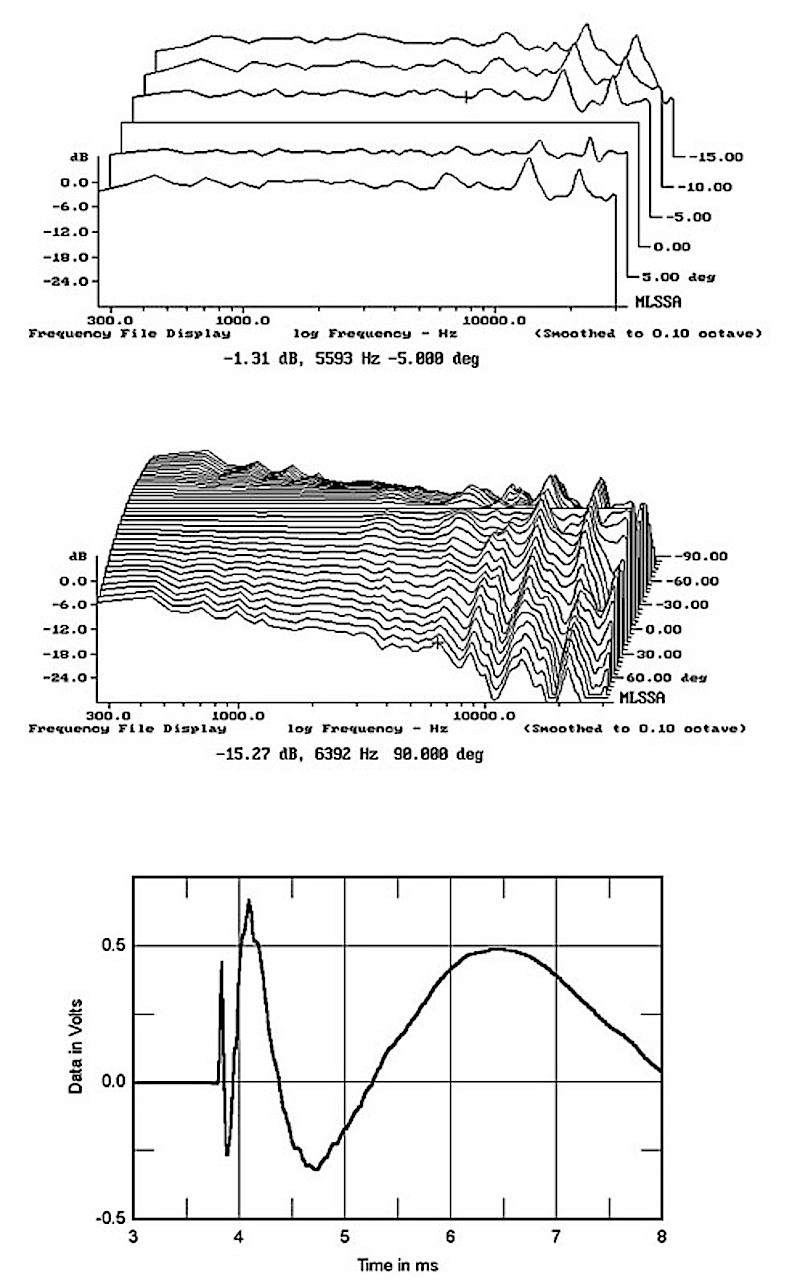
In the time domain, the TAD's step response on its tweeter axis indicates that all four drive-units are connected with positive acoustic polarity, with the tweeter's output arriving first at the microphone, followed by the midrange unit's output, then the woofers'. Most important, the decay of each unit's step blends smoothly with the start of that of the next lower in frequency, which confirms optimal crossover design […].
That said, and in the moment the original crossovers were dismantled, it was clear that there will be a lot to improve.
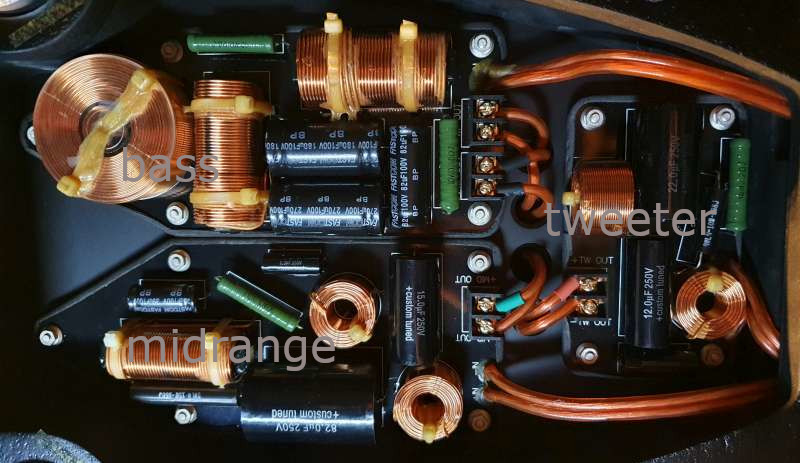
The crossover re-thought
My thinking was: Now Jan will reverse-engineer the original crossover scheme (the topology was unfortunately not provided by TAD Labs) and we will take it up from there. To my surprise he dismissed this idea and preferred to start on a blank screen. As he puts it “I do not want to get constrained by someone else´s thinking that this is the best design.”
To design a crossover for concentric drivers is somewhat special. The concentric designs are beating the conventional ones with one-acoustic-centre-arrangement for both the tweeter and the midrange driver, which results into excellent imaging capabilities. But there is also one disadvantage in such an arrangement - the tweeter is behind the midrange driver and to phase-align both represents a challenge. Also, the TAD’s driver is beryllium/magnesium. The light and stiff metallic cone always feature distortion at its break-up point. So it took several simulations before we arrived at an acceptable result, that could be used as a starting point for further tweaking. Only then we looked at the original crossover to compare. For owners of the TAD Evolution One speaker the scheme may come in handy:
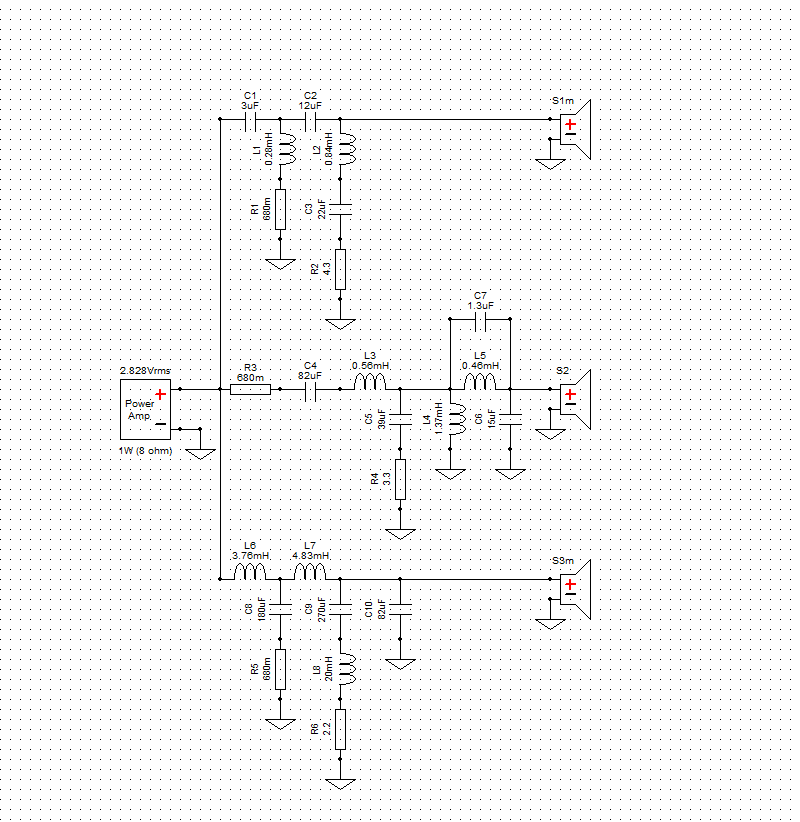
The process as Silent Laboratories people see it
Andrew Jones and the team of TAD used steep slope filters to mitigate the challenges of beryllium and magnesium. The steep filters suppress resonances to non-audible range and make time-alignment of the tweeter and midrange driver possible. This, in turn, is essential for achieving good sound. The disadvantage of the filters is in more complicated topology with more parts in the crossover. Therefore, the goal of the Silent Laboratories optimization was to simplify the crossover layout and voice the speaker to Audiodrom´s preferences.
In the original Evolution One simulation, that is the one based on measurements of individual drivers, one can see very even bass response between 80-230Hz (Fig.1). The bass response is of course very dependent on room modes - the frequency response will be modulated by them in the listening seat, room by room. Interestingly, the TAD’s original design slightly highlights the midrange, that correlated with the listening impressions in the reference room – the bass was tuneful yet less prominent, and the playback provided excellent insights into what happened in the music as the mids were in the spotlight. In relation to 1kHz reference point, the 2-8kHz range is a bit understated, though. In these octaves the human ear is very sensitive, especially as far as temporal imperfections are concerned. Unless the drivers are perfectly in phase (dotted lines in the chart for drivers, blue line for drivers’ combination), the sound will feel not quite right. Subpar crossover components will only aggravate all these problems, or they will mask them by their own distortions. Therefore, it is extremely important to get the phase right and use the best parts available to finely balance the phase- and frequency response.
Fig.1 – the original TAD Evolution One crossover
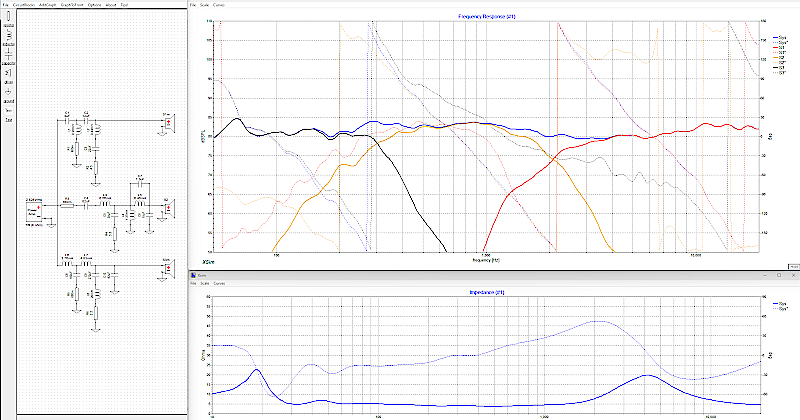
Unfortunately, the very first simulations made clear that the new crossover design could not be simplified as much as we wanted. We still had to tackle the gap between the acoustic centres of the tweeter and the midrange driver, and beryllium/magnesium left little room to change the crossover points. Yet, many hours and many simulations later, we arrived at the simulation #14 (!) that improved the phase and flattened the frequency response across mids and highs (Fig.2). On paper, the crossover topology is quite similar to the original, but it is not. All the filters must have been reviewed and basically none part was left in its nominal value. The progress was made in the bass, where we could skip some compensations and get desirable boost in the low-end, without losing the steepness of roll-off. In the original crossover, the dual bass drivers’ phase deviates from that of the midrange driver. To tackle that we needed to make some parts on order, according to our own specifications. For the simulation in the Fig.2 we used the closest values that were available off-the-shelf, so one can still see the phase-alignment imperfections. Yet, after the listening tests were completed, we knew this direction was very promising.
Fig.2
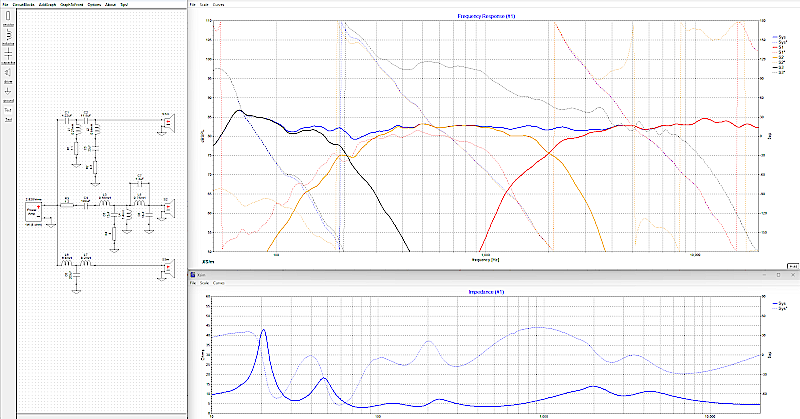
Throughout the journey, we also stopped to be concerned about fluctuations of the impedance curve – there was no plan to use subpar amplifiers for the TAD anyway, and the attempts to compensate the impedance had very negative impact on sound (although they had very positive impact on plots in graphs). It was a good example of listening experience contradicting engineering experience. Not because the design was wrong, but because the extra parts in the crossover introduced too much damage by their presence.
In parallel to topologies, we were also testing hardware, that is different types of coils, inductors, and resistors. And although I could populate this article with measurements and plots, it would not say anything to anyone, as we worked with one particular speaker with particular parts in one particular room. Even if you own the TAD Evolution One and would like to make the Revolution One conversion for your room, I can tell you that your crossover will end up different. Perhaps not fundamentally, but it will. Take it as a proven fact.
One fact became clear during the project: the phase was the parameter we decided NOT to compromise, ever. Accuracy of the temporal information became the dictate of the new TAD Revolution One design. And to be completely honest, I also had to accept the fact that TAD speakers are ported and the port excludes achieving the same level of phase matching in the lowest octaves in real conditions. It was not that big problem, however, for it is the room that decides what the bass will be like and I knew it would be uneven in the end.
Voicing
There are several research papers that investigated into the correlation of the sound “as preferred by loudspeaker designers” and the sound “as preferred by listeners”. Most notably by Sean Olive et al (Listener Preferences for In-Room Loudspeaker and Headphone Target Responses, Audio Engineering Society, 2013 convention paper) and Floyd E. Toole (The Measurement and Calibration of Sound Reproducing Systems, Journal of the Audio Engineering Society, 2015). The preferred listening curves remarkably deviate from the flat room response. In fact, the more experienced listener, the bigger the deviation.
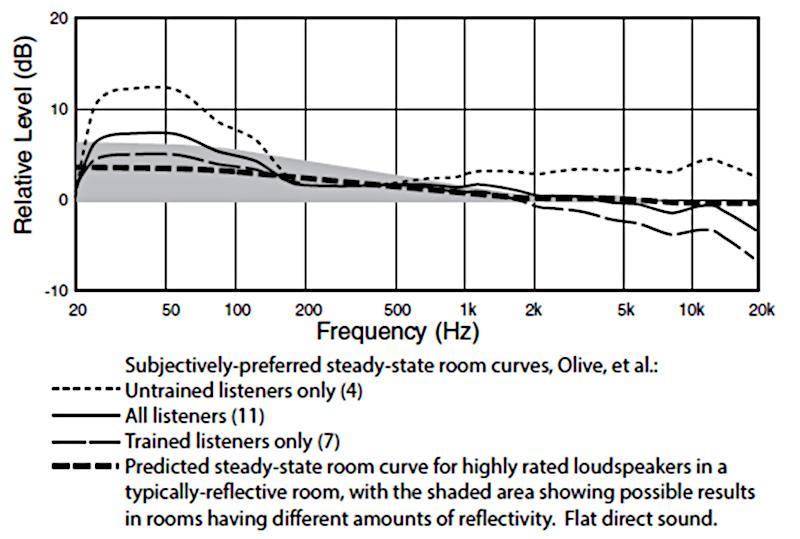
The research became the baseline for Harman’s Dirac processing which – in his optimum variant – adds +4dB vs reference line in the bottom octaves to improve the physiology of bass. The same target response fundamentals were adapted by e.g. Peter Lyngdorf for his Room Perfect digital room correction algorithm, that is also licensed by McIntosh for their room correcting devices.
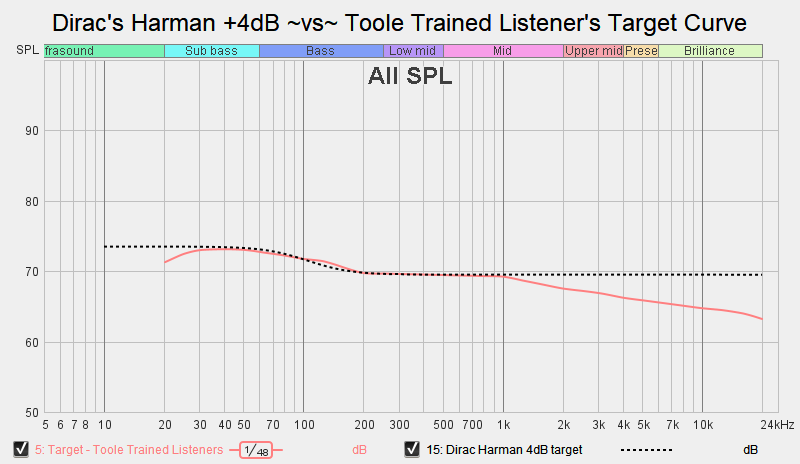
For headphone industry, Brüel & Kjær (B&K) have recently upgraded the 5128 measurement standard. The new measurement rig, launched in 2017, provides better data through more accurately simulating the human ear system (especially at lower and higher frequencies). Like Olive/Toole, B&K tried to match the auditory measurements with listeners preferences with loudspeakers and headphones. The chart below is taken from an article published by Headphones.com.
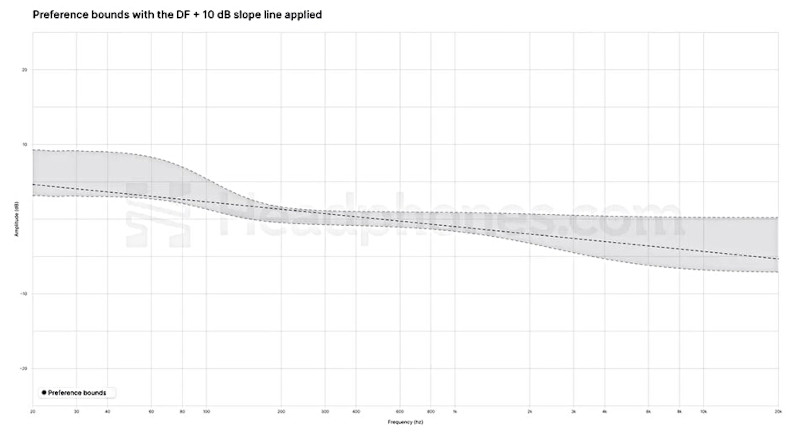
The ideal curve is the dotted line, and it de facto correlates with the Olive/Toole findings, especially when greyed out area is considered (the grey colour in the chart represents dispersion in preferences of listeners). Interestingly, B&K tests proved that if some playback parameters are outside the grey area, people find the sound unnatural. This is remarkable, because it basically means that anything else than less or more tilted downward slope is perceived imbalanced. Interestingly, the tilting pivot point at around 200-250Hz is where most speakers have the cross-over point set for woofers and midrange.
Of course, audiophiles love clarity, so it may be vital to introduce some extra presence to the sound to boost immediacy and intelligibility of the sound, mostly vocals. The following picture is the visual representation of the mastering curve that InAkustik used to master Charly Antolini’s Knock Out 2000, an album that epitomizes massive bass, seismic kick drum, present cymbals, and the mix which is considered to be one of the audiophile standards.
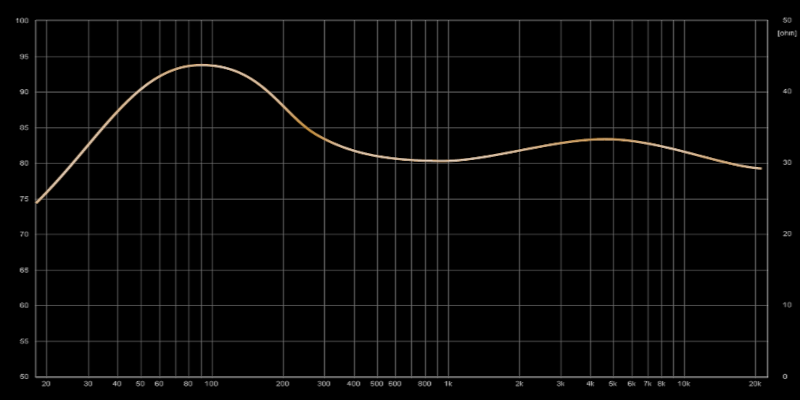
The most important take-away? Available research data correlate and converge to similar preferred listening curves. Most of the downward slope is automatically achieved in an average room by absorption of the room furnishings. Yet, if a loudspeaker is voiced with a bit too much presence, like the TAD Evolution One is, and if you listen relatively near-field, like me, the result may be a flatter curve then I want. Overdamping the room kills the sound (tested), so voicing the speaker for ‘pure musicality’ is a much better option. So, I did my homework and investigated which type of slope would work for me and my room. First on paper, then I used a cheap Behringer multiband equalizer to test how it would sound in room, with all the modes in.
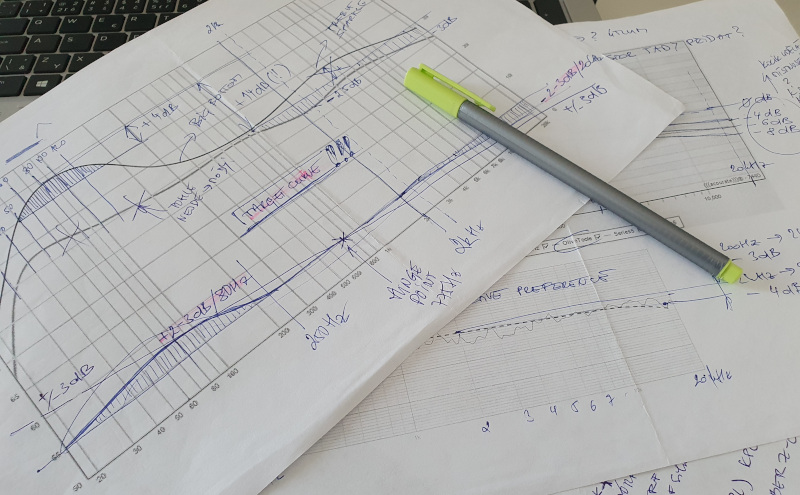
After employing custom-made values for most crossover parts, we improved sensitivity of the loudspeaker and perfectly aligned the bass to the midrange. Also, for the very final crossover topology of the TAD Revolution One, we agreed with Jan to create a very gentle slope and Silent Laboratories delivered this crossover masterplan:
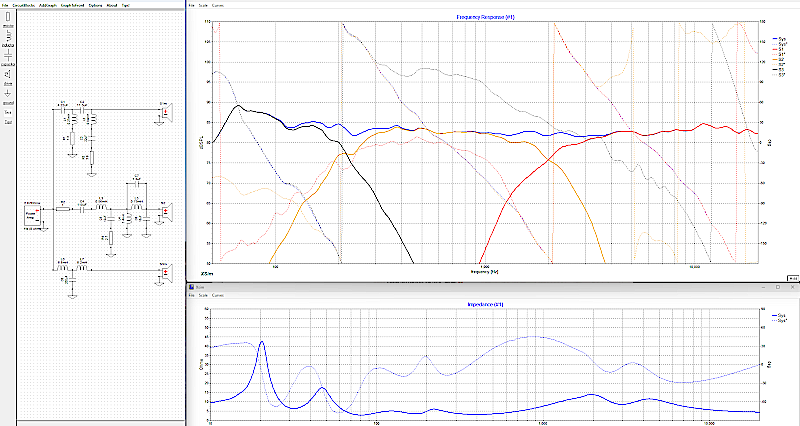
This final simulation was used to order all the crossover parts from suppliers. Although this point might seem to end the journey, it did not. I would say that deciding on the final crossover topology was 30-40% progress in the project from my current state of knowledge. Someone should have warned me that the most challenging things are yet to come.
To be continued...
Useful contacts:
Silent Laboratories – Jan Mixa, +420 777 772 642
TAD Revolution One / Part 1 – Cabinets
TAD Revolution One / Part 2 – Crossover
TAD Revolution One / Part 3 – Crossover parts
TAD Revolution One / Part 4 – Casework and fine-tuning
TAD Revolution One / Part 5 – Finale
(C) Audiodrom 2024



